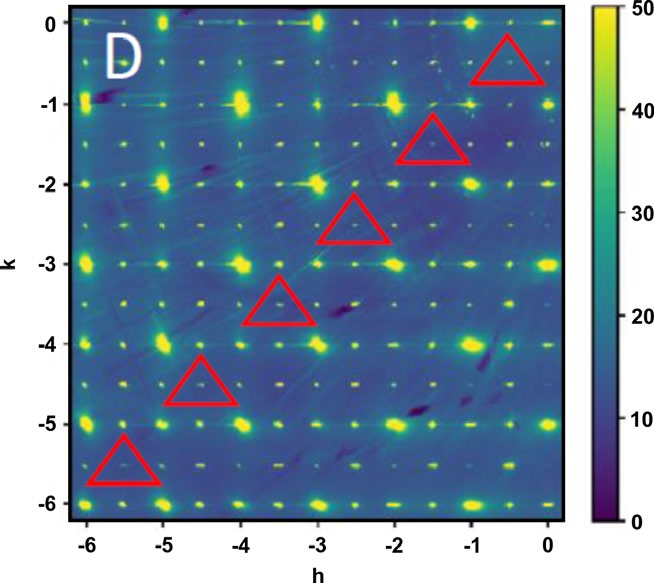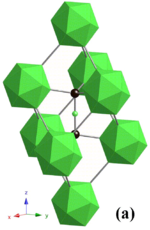The results show that air-cooling and water-cooling have little effect on TiC content of molten carbide blast furnace slag, and have great effect on crystal structure and grain size. TiC content in slag is different when carbide blast furnace slag is crushed in argon atmosphere and air atmosphere. A single-crystal, or monocrystalline, solid is a material in which the crystal lattice of the entire sample is continuous and unbroken to the edges of the sample, with no grain boundaries.The absence of the defects associated with grain boundaries can give monocrystals unique properties, particularly mechanical, optical and electrical, which can also be anisotropic, depending on the type of. China Boron Carbide (BC) catalog of Competitive Boron Carbide (B4C) Powder for Polishing Lapping Sapphire Jewels, Durable Boron Borium Carbide B4c Powder with High Grinding Efficiency provided by China manufacturer - Kumthai Abrasives Co., Ltd., page2. We report depressurization amorphization of single-crystal boron carbide (B4C) investigated by in situ high-pressure Raman spectroscopy. It was found that localized amorphization of B4C takes place during unloading from high pressures, and nonhydrostatic stresses play.
Realizing a New Semiconductor for Power Electronic Applications (MIP #32)

A PARADIM for Jumpstarting Academic Careers (MIP #31)
A Classic Model for Oxides gets a much-needed Update (MIP #30)
Accelerating Materials Discovery by Empowering Users—the MIP Difference(MIP #28)
PARADIM accelerates discovery of nanoscale chemical gradients in human enamel crystallites (MIP #26)
Materials Enabling a Magnetic 'Midas Touch' (MIP #25)
Mollifying Barriers to Enhance Self Assembly (MIP #19)
Floating Zone Crystal Growth at Record Oxygen Pressure to Create a PrNiO3 Single Crystal (MIP #18)
Growth of Stoichiometric B4C Single Crystal by Laser Floating-Zone Method (MIP #9)
Introduction:
Boron carbide (B4C) is an extremely hard material with a melting temperature above 2000°C; its electronic properties vary strongly with the precise composition.
Choose from our selection of T-slots, including T-slotted framing rails, T-slotted framing structural brackets, and more. In stock and ready to ship. Request Your New TSLOTS Catalog or Brochure Today! Request a catalog or brochure today and receive your FREE Hard copy. See information with all 120+ extrusion profiles and helpful resources with our hardware. Learn more. Aluminum T-Slotted Extrusions vs. Steel Extrusions. New black anodized tslots components We are continually adding new black anodized fasteners ranging from Joining Plate, Gussets, and Corner Brackets. These give you a variety of option and versatility to create your specific project with TSLOTS! T slot catalog. TSLOTS catalogs and brochures have been created to make your searching simple. Have any product question? Ask a TSLOTS expert today and find what you are looking for! Request a catalog or brochure today and receive your FREE Hard copy.
PARADIM's Tilting Laser Diode Floating Zone Furnace enables users to routinely grow B4C single crystals for further study. The in-situ monitoring of gas-phase species during the growth provides insights on the underlying mechanism by which the composition changes and enables the successful growth of single crystals with controlled stoichiometry. Various growth rates were explored to mitigate microstructure defects (including stacking faults, SF) and zone refinement allowed for a significant reduction of trace impurities. Initial analysis by powder x-ray diffraction confirms that the crystals are indeed rhombohedral B4C, with a hardness of 41±1 GPa and a Young's modulus of 520±14 GPa revealed by nano-indentation. Laser light was found to induce graphitization in the presence of air, enabling a new process to fabricate electronic structures in boron carbide with micron or nanoscale precision.
B4c Single Crystal Lake
M. Straker et al. J. Cryst. Growth543, 125700 (2020).
B4c Single Crystal Necklace
M.V.S. Chandrashekhar et al., U.S. Patent No. US20190352234-A1 (21 November 2019).
Figure 1: (top left) Photograph of a boron carbide crystal. (bottom left) View into the laser diode floating zone furnace (right) Scanning electron microscopy images of a B4C single crystal with indicated stacking fault lines. |
Technical details: We report the growth of 4 mm diameter × 50 mm long Boron Carbide (B4C) with large single crystal regions using a Laser Diode Floating Zone (LDFZ) method at varying growth rates of 5–20 mm/hr. These materials were grown using polycrystalline B4C as a seed. Microstructural characterization shows the presence of a significant number of twinning-boundaries along the growth direction ([0 0 1]h) oriented in the (1210)h plane. At faster growth rates >10 mm/hr, the crystal orientation was reproducible, suggesting a twin-plane mediated growth mechanism. On the contrary, at slower growth rates <10 mm/hr the crystal orientation was not reproducible, suggesting a critical rate for twin-plane mediated growth to dominate.

Zone refinement of these crystals led to a significant reduction of trace impurities to better than 99.999 wt% purity, at the expense of increased twinning. Powder x-ray diffraction confirms that the bulk is rhombohedral B4C, consistent with the microstructural analysis. The X-ray reciprocal space maps reveal the growth direction to be close to the [001]hdirection, and the corresponding ω-rocking curve width is ~530 arcsec. The rocking curve consisted of 3 distinct peaks, indicating in-plane mosaicism, consistent with the twinning observed. Berkovich nano-indentation of the key (001)h plane showed 41 ± 1 GPa hardness, with a Young's modulus of 520 ± 14 GPa, comparable to literature reports. In addition, it was discovered that the laser field could induce graphitization of boron carbide in air, a new, previously unknown phenomena that led to a patent application due to the potential uses of the technique in fabricating electronic structures in single crystal boron carbide substrates.
Researchers of Morgan State University initialized and performed the work at the PARADIM Bulk Crystal Growth Facility located at John Hopkins University.



A PARADIM for Jumpstarting Academic Careers (MIP #31)
A Classic Model for Oxides gets a much-needed Update (MIP #30)
Accelerating Materials Discovery by Empowering Users—the MIP Difference(MIP #28)
PARADIM accelerates discovery of nanoscale chemical gradients in human enamel crystallites (MIP #26)
Materials Enabling a Magnetic 'Midas Touch' (MIP #25)
Mollifying Barriers to Enhance Self Assembly (MIP #19)
Floating Zone Crystal Growth at Record Oxygen Pressure to Create a PrNiO3 Single Crystal (MIP #18)
Growth of Stoichiometric B4C Single Crystal by Laser Floating-Zone Method (MIP #9)
Introduction:
Boron carbide (B4C) is an extremely hard material with a melting temperature above 2000°C; its electronic properties vary strongly with the precise composition.
Choose from our selection of T-slots, including T-slotted framing rails, T-slotted framing structural brackets, and more. In stock and ready to ship. Request Your New TSLOTS Catalog or Brochure Today! Request a catalog or brochure today and receive your FREE Hard copy. See information with all 120+ extrusion profiles and helpful resources with our hardware. Learn more. Aluminum T-Slotted Extrusions vs. Steel Extrusions. New black anodized tslots components We are continually adding new black anodized fasteners ranging from Joining Plate, Gussets, and Corner Brackets. These give you a variety of option and versatility to create your specific project with TSLOTS! T slot catalog. TSLOTS catalogs and brochures have been created to make your searching simple. Have any product question? Ask a TSLOTS expert today and find what you are looking for! Request a catalog or brochure today and receive your FREE Hard copy.
PARADIM's Tilting Laser Diode Floating Zone Furnace enables users to routinely grow B4C single crystals for further study. The in-situ monitoring of gas-phase species during the growth provides insights on the underlying mechanism by which the composition changes and enables the successful growth of single crystals with controlled stoichiometry. Various growth rates were explored to mitigate microstructure defects (including stacking faults, SF) and zone refinement allowed for a significant reduction of trace impurities. Initial analysis by powder x-ray diffraction confirms that the crystals are indeed rhombohedral B4C, with a hardness of 41±1 GPa and a Young's modulus of 520±14 GPa revealed by nano-indentation. Laser light was found to induce graphitization in the presence of air, enabling a new process to fabricate electronic structures in boron carbide with micron or nanoscale precision.
B4c Single Crystal Lake
M. Straker et al. J. Cryst. Growth543, 125700 (2020).
B4c Single Crystal Necklace
M.V.S. Chandrashekhar et al., U.S. Patent No. US20190352234-A1 (21 November 2019).
Figure 1: (top left) Photograph of a boron carbide crystal. (bottom left) View into the laser diode floating zone furnace (right) Scanning electron microscopy images of a B4C single crystal with indicated stacking fault lines. |
Technical details: We report the growth of 4 mm diameter × 50 mm long Boron Carbide (B4C) with large single crystal regions using a Laser Diode Floating Zone (LDFZ) method at varying growth rates of 5–20 mm/hr. These materials were grown using polycrystalline B4C as a seed. Microstructural characterization shows the presence of a significant number of twinning-boundaries along the growth direction ([0 0 1]h) oriented in the (1210)h plane. At faster growth rates >10 mm/hr, the crystal orientation was reproducible, suggesting a twin-plane mediated growth mechanism. On the contrary, at slower growth rates <10 mm/hr the crystal orientation was not reproducible, suggesting a critical rate for twin-plane mediated growth to dominate.
Zone refinement of these crystals led to a significant reduction of trace impurities to better than 99.999 wt% purity, at the expense of increased twinning. Powder x-ray diffraction confirms that the bulk is rhombohedral B4C, consistent with the microstructural analysis. The X-ray reciprocal space maps reveal the growth direction to be close to the [001]hdirection, and the corresponding ω-rocking curve width is ~530 arcsec. The rocking curve consisted of 3 distinct peaks, indicating in-plane mosaicism, consistent with the twinning observed. Berkovich nano-indentation of the key (001)h plane showed 41 ± 1 GPa hardness, with a Young's modulus of 520 ± 14 GPa, comparable to literature reports. In addition, it was discovered that the laser field could induce graphitization of boron carbide in air, a new, previously unknown phenomena that led to a patent application due to the potential uses of the technique in fabricating electronic structures in single crystal boron carbide substrates.
Researchers of Morgan State University initialized and performed the work at the PARADIM Bulk Crystal Growth Facility located at John Hopkins University.
Full references:
Michael Straker, Ankur Chauhan, Mekhola Sinha, W. Adam Phelan, M.V.S. Chandrashekhar, Kevin J. Hemker, Christopher Marvel, and Michael Spencer, 'Growth of high purity zone-refined Boron Carbide single crystals by Laser Diode Floating Zone method,' J. Cryst. Growth543, 125700 (2020).
M.V.S. Chandrashekhar, Joshua Letton, Travis Williams, Abdulganiyu Ajilore, and Michael Spencer 'Laser Induced Graphitization of Boron Carbide in Air,' U.S. Patent No. US20190352234-A1 (21 November 2019) https://patents.google.com/patent/US20190352234A1/en.

